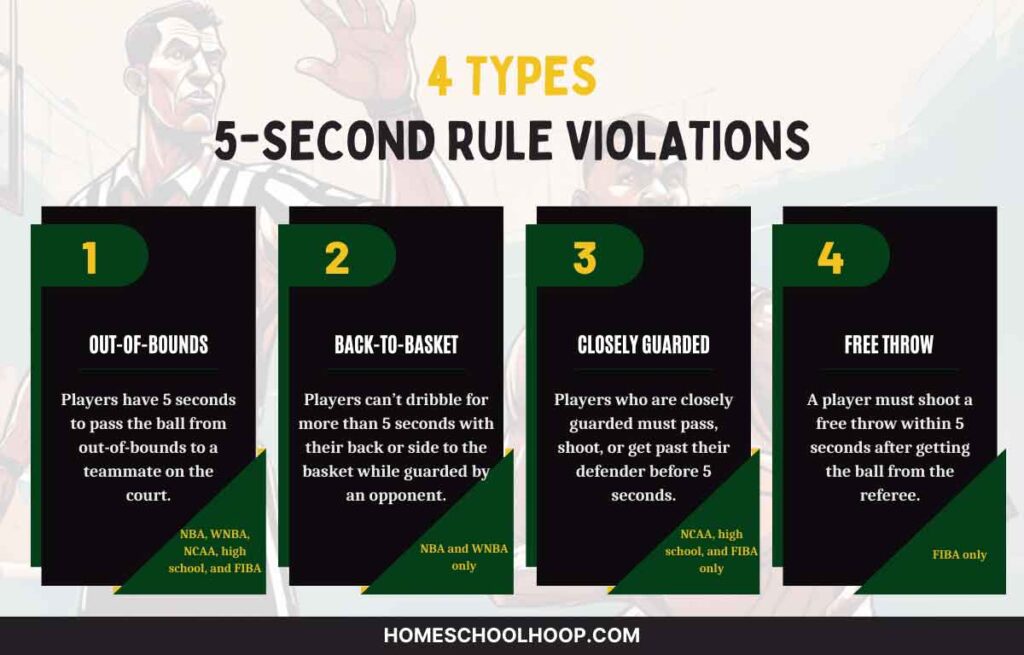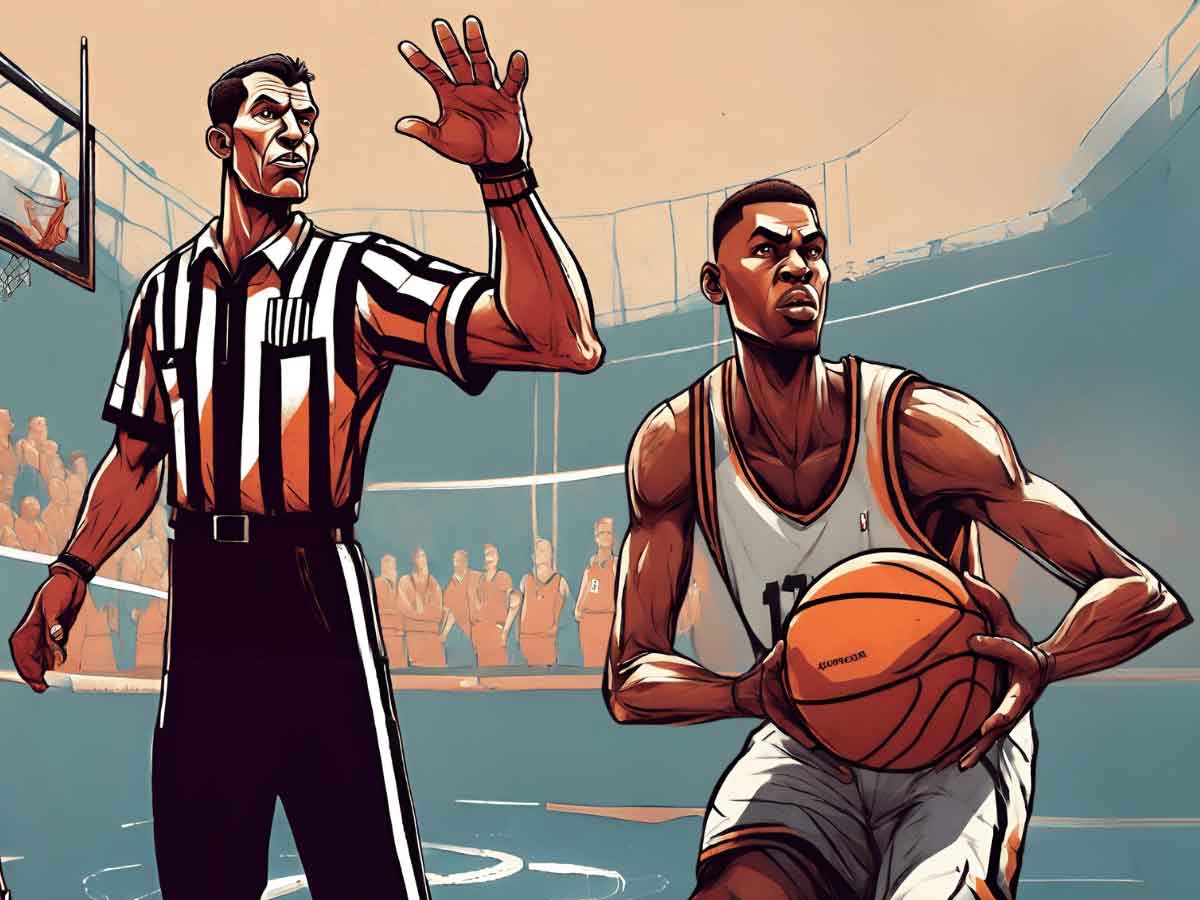Imagine it’s the last few seconds of a nail-biting basketball game. The team with the ball is trying to pass it in, but the other team’s defense is all over them. They’re racing against a critical countdown – the 5 second rule in basketball.
This is just one of four types of the 5 second rule in basketball that players must navigate. It can decide whether a team keeps the ball or loses a chance to score.
Key Takeaways:
- The 5 second rule in basketball refers to the time a player has to either inbound the ball, avoid closely guarded situations, shoot a free throw, or dribble with their back to the basket.
- Violations of this rule result in a turnover, giving the opposing team the ball.
- Both teams can use this rule to their advantage, whether they have the ball or are trying to get it back.
Let’s break down the four types of the 5-second rule and see how they can change the course of the game.
Understanding the 5-Second Rule
The 5 second rule in basketball is a timer for players. It’s designed to ensure that the keep keeps moving. Without it, players might take too long and slow down the action. With the rule in place, they have to think and act fast.
Simply put, when the clock starts ticking, players have 5 seconds to make a move. If they don’t, it’s a turnover in basketball, giving the ball to the other team.
The most common 5-second rule is the out-of-bounds throw-in rule, which has been in place since Dr. James Naismith created the sport of basketball.
“The thrower-in is allowed five seconds; if he holds it longer, it shall go to the opponent.”
Dr. James Naismith’s Original 13 Rules of Basketball
Today, there are four types of the 5-second rule in basketball, although some are exclusive to certain leagues. Each of these basketball rules is meant to improve game pace by preventing teams from stalling or wasting time.
TRIVIA: GUESS THE PLAYER
One player in particular is credited with being one of the main reasons the NBA implemented the 5 second back-to-the-basket violation. How many clues do you need to identify him?
Clue 1: This player, known for his dominance in the post, was a dynamic and aggressive NBA power forward from 1984 and 2000.
Clue 2: He had a legendary career with the Philadelphia 76ers, Phoenix Suns, and Houston Rockets.
Clue 3: Nicknamed “The Round Mound of Rebound,” he’s also famous for his sports commentary.
Scroll to the bottom for the answer.
The Four Types of 5 Second Rules in Basketball
The 5 second rule in basketball isn’t just one rule but a set of four distinct types. Each type has its place, with its purpose of keeping the game moving so that it’s fair and fun to watch.

1. The 5 Second Out-of-Bounds Violation
This is the original 5 second rule that’s been in place since the game was invented. It’s still the most common type of five-second violation.
The 5 second out-of-bounds rule kicks in during inbounds plays. Players have 5 seconds to pass the ball from out-of-bounds to a teammate on the court. If they fail to do so, it’s a turnover and the opposing team gets the ball from the same out-of-bounds location.
- Where it applies: It’s a universal inbounding rule across NBA, WNBA, NCAA, and high school basketball.
2. The 5 Second Back-to-The-Basket Violation
The 5 second back-to-the-basket rule limits how long a player can dribble with their back or side to the basket while being guarded by an opponent.
You can thank NBA post players in the 1990s for this rule. It was introduced in 1999 after players repeatedly used this style of play in the post and slowed down the game so much it was nearly unwatchable.
3. The 5 Second Closely Guarded Violation
The 5 second closely guarded violation occurs when a player holding or dribbling the ball is closely guarded and doesn’t pass, shoot, or get past the defender for 5 seconds.
This rule was created in 1930, although the original penalty for this violation used to be a jump ball. In today’s basketball, the penalty is a turnover.
- Where it applies: In NCAA, high school, and FIBA. Not the NBA or WNBA.
4. The 5 Second Free Throw Violation
Under the 5 second free throw rule, a player must shoot a free throw within 5 seconds after getting the ball from the referee.
- Where it applies: This rule is specific to FIBA games.
Offense and Defense Strategies
For teams, understanding how to work with and against the 5 second rule in basketball is crucial. Let’s look at some basic strategies related to these basketball violations that players use on both ends of the court.
Offense Strategies: Avoiding the 5-Second Violation
- Smart Inbounding: When inbounding, know the options coming out of the set play you’re running so you’re ready to pass at the perfect time.
- Fast Decision-Making: When in the post with your back to the basket, read the defense’s position quickly so you make your move before hitting the 5-second mark.
- Effective Dribbling: Keep the dribble alive and purposeful. Improve your ball handling to avoid getting trapped in one spot for too long.
Defensive Tactics: Forcing the 5 Second Rule
- Applying Pressure: Stay close to your opponent. The goal is to make them uncomfortable and limit their options.
- Team Coordination: Work with teammates to cover all potential pass receivers, especially during inbounds plays and trapping opportunities.
- Anticipation: Study film and read the opponent’s next move. If you can predict it, you can disrupt it.
The 5-Second Rule’s Impact on Game Play
The 5-second rule keeps basketball games moving. Both offense and defense have to adapt their strategies to the rule. Here are some of the ways it influences pace, basketball tactics, and defensive and offensive strategy:

Pace and Pressure
- Speeds up the game: This rule forces players to act quickly, keeping the game fast-paced and exciting.
- Creates pressure: Players under the 5-second count feel more defensive pressure, which can lead to hasty decisions or mistakes.
Strategy and Planning
- Set inbound plays: Teams must plan basketball screens or quick cuts to get open when inbounding the ball. There’s no time for hesitation.
- Possession change opportunities: Defenders use this rule to their advantage, applying pressure to force turnovers.
The 5-second rule in basketball adds urgency and excitement. It can also be a game-changer in crucial moments, affecting the outcomes of high-stakes games.
In the example below, Lithuania successfully pressures Italy into a 5-second violation. This successful defense gives them the ball back and helps prevent Italy from gaining momentum as they try to battle back from a deficit.
The Relationship with Other Rules
Basketball’s 5-second rule doesn’t work alone. It’s part of a network of time-related rules that include things like the shot clock, lane violations, and more, all to keep play fair and faster.
Players have to be aware of all of these time management rules simultaneously. While avoiding a 5-second violation, players must also be mindful of not committing these other time violations. Awareness and communication are essential, so teams use signals and calls to help each other.
The Shot Clock
- Shock Clock Basics: Players have a limited time (24-30 seconds, depending on the level) to attempt a field goal.
Lane Violations
- Lane Violation Basics: Offensive players can’t stay in the key area (lane) for more than 3 seconds, regardless of whether they have the ball.
- NBA and WNBA-specific rules: The NBA and WNBA also have in place a defensive 3-second rule. This prevents defenders from spending more than 3 seconds in the key without actively guarding an opponent.
10-Second Rule
- 10-Second Rule Basics: Teams have 10 seconds to move the ball past the mid-court line. One defensive court strategy is to apply pressure full court to try to get this 10-second violation call.
FAQs
What is the 5-second rule in basketball?
The 5-second rule in basketball is a set of rules that gives players a maximum of 5 seconds to make specific moves. These include passing the ball inbounds, avoiding being closely guarded, dribbling with one’s back to the basket, and shooting free throws in certain leagues.
What is the 5 second inbound rule in basketball?
The 5 second inbound rule requires the player passing the ball in from out-of-bounds to do so within 5 seconds. If they take longer, the opposing team gets the ball.
Why is there a 5-second rule in basketball?
The 5-second rule exists to keep the game moving at a fast pace. It prevents players from delaying the game and ensures an active style of play.
When was the 5 second rule implemented in the NBA?
The original 5-second inbounds rule has been a part of the NBA from the league’s beginning. The newer 5-second back-to-the-basket violation was added to the NBA rules in 1999.
Can you hold the basketball for more than 5 seconds?
It depends on the situation. In general, you can’t hold the ball for more than 5 seconds when closely guarded, inbounding, or dribbling with your back to the basket. In other situations, like when not closely guarded, you can hold it longer.
LET US KNOW
Today, you learned about the 5 second rule in basketball and how it can lead to possession changes during crucial moments.
So we want to know: Have you ever watched or played in a game where the 5-second rule dramatically changed the outcome?
Let us know in the comments.
The GUESS THE PLAYER TRIVIA answer is Charles Barkley.

